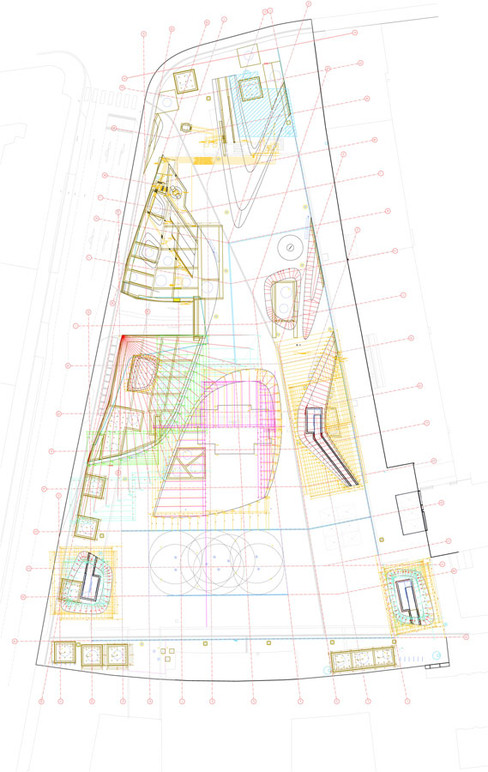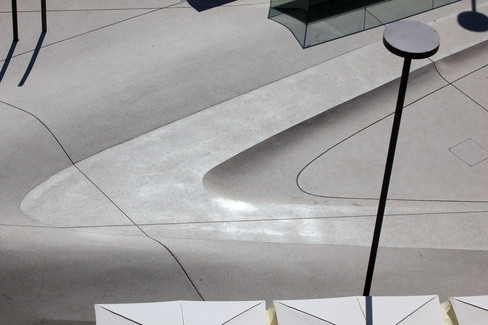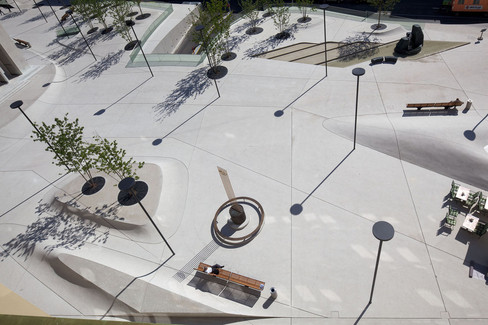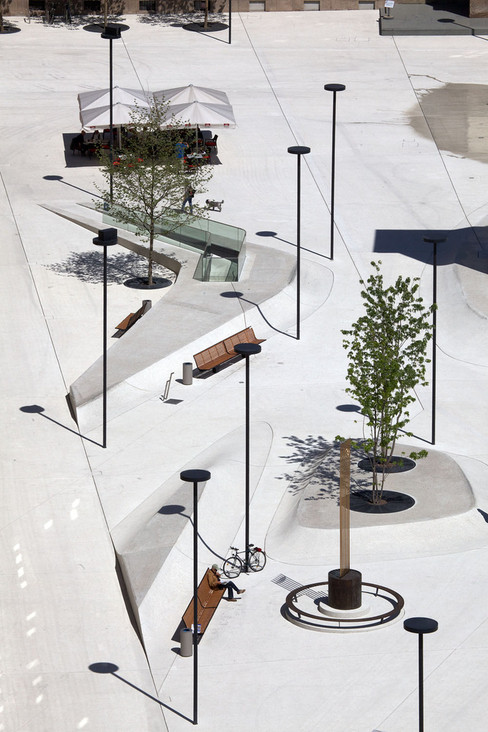
The goal of the intervention at Eduard-Wallnöfer-Platz (Landhausplatz) was to create a contemporary urban public space that negotiates between the various contradictory conditions and constraints of the site and establishes a stage for a new mélange of urban activities characterized by a wide diversity. The realized project consists of a 9.000 square meter concrete floor sculpture.
Before the transformation took place, the square’s atmosphere and spatial appearance was dominated by the facing facade of the Tyrolean provincial governmental building from the period of National Socialism, and by a large scale memorial resembling a fascist monument – which, in fact and in spite of its visual appearance, is a freedom monument that shall commemorate the resistance against, and the liberation from National Socialism. The intervention aims to compensate for existing misconceptions and to reinforce the monument’s historical significance. The new topography of the square offers a contemporary and transformative base for the memorials and makes them accessible – physically and regarding a new perception.
The new topography creates a landscape-like counterpart to the surrounding, but it turns into an urban sculpture through its urban context, its concrete finish and through its function. Accessibility and the layout of paths result from the modulation of the surface, which responds to spatial constraints, functional requirements and with morphological considerations. Pedestrians and users, as well as the memorials in their role as protagonists on this new city stage, allow for an operative public and open forum between main station and old town. The bright surface of the square functions as a three-dimensional projection field on which the protagonists together with the trees cause a high-contrast dynamic play of light and shadow during the daytime. In front of this background the seasons are staged powerfully. Indirect light reflected from the floor sculpture directs the scenery at night.
In the northern part of the square, the spacious flat area in front of the Landhaus is conceived as a generous multi-purpose event space providing the according infrastructure. A large scale fountain activates the expanded field and provides cooling-down in summertime.
South of the liberation monument the topography features a variety of spatial situations for manifold utilizations. The texture of the concrete surface varies according to the type of geometrical configuration. Beneath many trees the floor continuously merges into seat accommodations with a terrazzo-like polished finish.
The sculpture group of one of the monuments is integrated into the basin of a new fountain where water runs down steps cut into a slope. The shoal fountain and the water games in front of the Landhaus provide a playground for children and a local cool-down spot in the summertime. There are drinking fountains in different heights for children and adults.
The surface of the square is realized in modulated slabs out of in-situ concrete, joined by bolts that deal with shearing forces. Infrastructural elements for the organization of events which can take place anywhere on the square are integrated in the construction of slab-fields of max. 100 square meter. Drainage of the whole square including the fountains is located completely at the open joints between the individual fields so that there is no drainage pit visible on the site. An innovative buffer system allows for this – despite the existence of a subterranean garage – maintaining all the visible surface water drains away within the property.
Press kit: Landhausplatz | Eduard Wallnöfer Platz







Stiefel Kramer Architecture, Wien
Christopher Grüner, Künstler, Innsbruck
Design: Kathrin Aste, Frank Ludin, Peter Griebel, Thomas Feuerstein
Execution: Kathrin Aste, Frank Ludin, Thomas Feuerstein, Peter Griebel
Construction supervision: Baumeister Ing. Stefan Heiss, Stans
Structural engineering: Dipl. Ing. Alfred Brunnsteiner, Natters
HVAC design: A3 jp-Haustechnik GmbH&Co, Innsbruck
Electrical design: A3 Jenewein Ingenieursbüro Gmbh, Innsbruck
Light design: Halotech Lichtfabrik, Innsbruck








- LHP Landhausplatz | memory landscape
- Ein Teppich für die Stadt - Landhausplatz Innsbruck
- Award of the Land Tyrol for New Building
- Neugestaltung Eduard Wallnöfer Platz
- New Design for Eduard Wallnöfer Platz
- Nomination Mies van der Rohe Award
- Nomination ZV Bauherrenpreis
- Piranesi Awards - Honorable Mention
- Tag der offenen Tür Eduard-Wallnöfer-Platz
- aut. vorort
- 1st prize Architect's Competition
- LHP Landhausplatz | Eduard Wallnöfer Platz
- Nimm 3 - Platz gemacht
